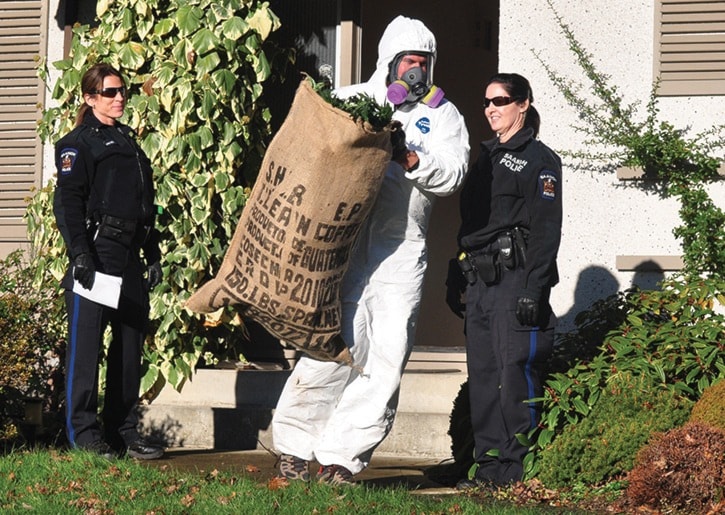Last December, Saanich police seized 700 marijuana plants from a nondescript bungalow home in a leafy residential neighbourhood.
As local residents pointed out, every few months the house would belch out great plumes of marijuana smell. For this sizeable commercial operation, it wasn’t so much if it would be busted, but when.
But for the operators, the cash income far outweighed the near certainty the police would eventually boot down the door. Each grow-cycle of two or three months likely brought in about $150,000 in cash, even after expenses.
This goes against the messaging of police agencies and government, but in many cases, crime can pay.
The illegal economy in Greater Victoria – growing and selling drugs, money laundering, thefts and frauds – is anecdotally lucrative and only somewhat dangerous, but extremely difficult to even to estimate. Statistics Canada issued a study of Canada’s underground economy, but omitted illegal activities “due to the difficulty of obtaining reliable source data.”
Police can provide a sense of the scale of the illegal economy, which is dominated by the drug trade – marijuana grow-ops and trafficking in powder cocaine, crack, meth and heroin.
Const. Aaron Stuart, with the Saanich police street crimes unit, estimates his unit busts a couple large scale marijuana grow-ops each month, on the order of 500 to 1,000 plants. A house busted last December with 534 plants produced about 66 pounds of bud each cycle, he says, with each pound going for $1,500 to $2,000.
“Low-balling it at $1,500 a pound, you are looking at $100,125,” Stuart says. As the bud is cut and sold in smaller quantities, the single crop will yield about $300,000, and most grow-ops achieve at least a few cycles before being robbed or busted.
A Simon Fraser University study from 2004 by economics professor Stephen Easton estimated that Vancouver Island hosted about 3,200 grow-ops in the year 2000, generating about $1.3 billion in revenues.
In an interview with Black Press earlier this year, Easton said he suspects that the scope of the grow-op industry hasn’t changed much over the last decade, although like any report on the economics of crime, he cautions that his numbers are akin to an educated guess.
“The technology for grow-ops has gotten better so there’s an increase in supply,” he says. “But the demand has gone down in the U.S. due to the rising Canadian dollar.”
Easton also suggested that the dollar value of the illegal economy is probably less than people suspect, largely due to illicit income quickly being absorbed into spending on legal goods and services. Drug traffickers buy homes, cars and furniture too. “Even the guys doing illegal stuff need to buy hot dogs,” he says.
And those guys buying hot dogs aren’t hard up for cash. Const. Jason Eagles, with the Victoria police Strikeforce Unit, said his team could bust “dial-a-dopers” – mid-level drug traffickers – every day of the week if they had the manpower.
“At any given time we have two or three investigations on the go,” Eagles says. “When we complete one, we roll right into the next. There is enough people in the drug trade to keep us busy.”
“It’s extremely lucrative for guys dealing with powder cocaine,” Stuart notes. “We debriefed one guy who cleared $5,000 per week above his car, house, phone and workers. And that guy was just some joe-blow slinging it and making his own business.”
The downside to all that cash? The lifestyle can be stressful and constantly fraught with violence or inconvenient arrests.
Victoria doesn’t have the level of drug-fuelled violence of Surrey, for instance, but many drug traffickers here have connections to Mainland gangsters.
“You’re always worried about the police kicking down your door or other criminals robbing you,” Stuart says. “You wonder who’s watching you. You have to hide everything you are doing.”
The risk, too, is that once arrested, the Ministry of Justice might look to seize ill-gotten gains through civil forfeiture legislation. If the Civil Forfeiture Office thinks it can prove a drug trafficker’s car, house, boat, jewelry or stacks of cash is the outcome of illegal activity, it can appeal to a civil court to seize those goods.
In six years and 950 cases (including about 95 cases on Vancouver Island), the Civil Forfeiture Office has seized $30 million in assets across the province, and referrals from police increase each year.
In 2011-12 it seized $10.8 million alone, and the province created a less onerous “administrative forfeiture” process to seize goods worth less than $75,000.
“We seize and turn that cash into community grants,” said Lynda Cavanaugh, an assistant deputy minister with the Ministry of Justice. “It’s a creative way to show that crime doesn’t pay.”
If fellow criminals, police agencies and the Ministry of Justice can’t cut into a trafficker's income, the taxman just might. Income, from legal and illegal sources alike, must be declared to the Canada Revenue Agency.
The CRA’s special enforcement program investigated more than 3,300 people in 2010-11 suspected of not paying taxes on income derived from illegal sources.
“Bottom line is, taxpayers have to report all income,” says Dave Morgan, who speaks for the CRA in Vancouver.
editor@saanichnews.com
